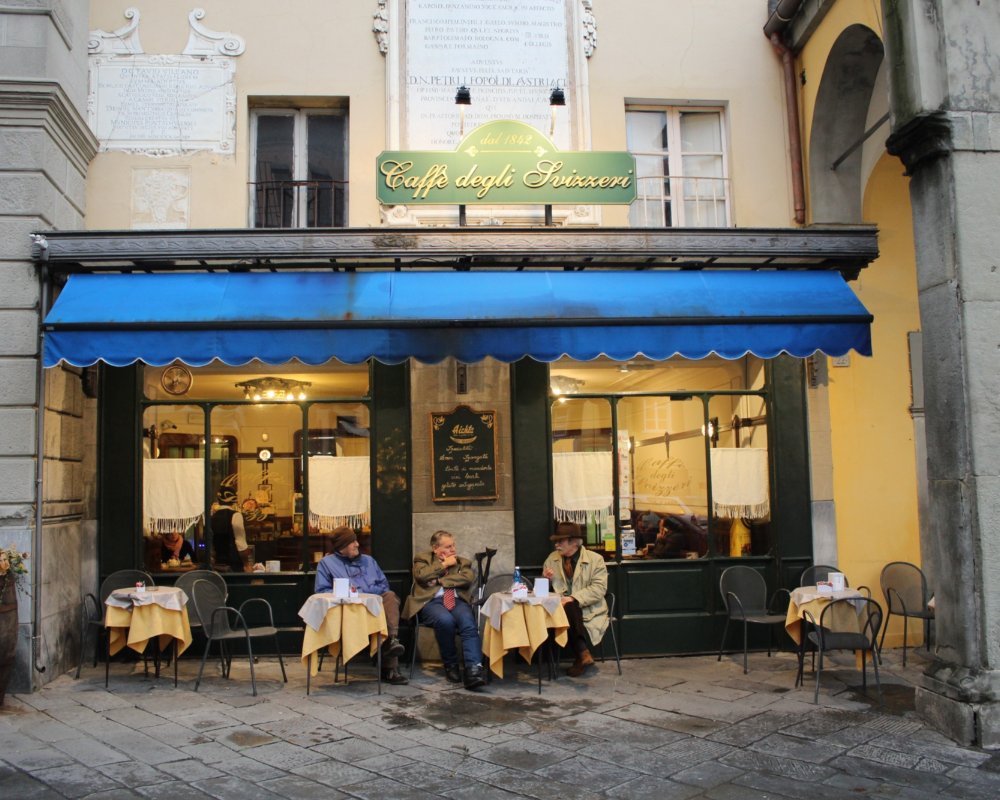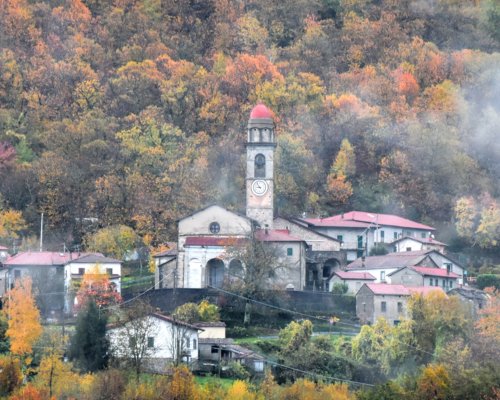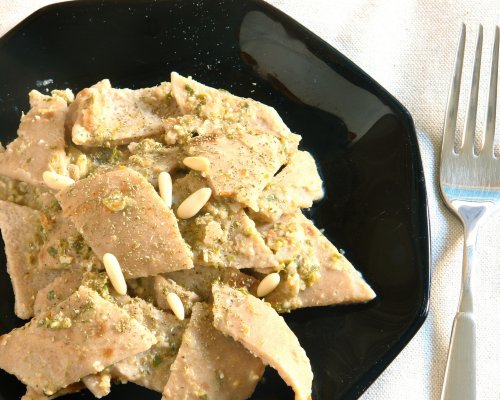Palate-pleasing in the Tuscan portion of the twofold region
Lunigiana’s heart is torn between Tuscany and Liguria—literally, it’s spread across the two regions, with its lifeblood the Magra River running through it. Though its visibility spiked after actor George Clooney purchased a villa outside Pontremoli, there’s far more to this region than its A-list vacationers. At the top of the list is the food and wine, with bread as the key building block for most of the area’s trademark dishes and products. But no time for “loafing”—let’s start exploring.
Pontremoli is a perfect first stop for whetting your palate. Begin with a Lunigiana classic, a hearty plate of testaroli al pesto. Think of this Roman and Etruscan vestige as “Tuscan pancake pesto pasta”. First a large and thin pancake-like base is prepared using just water, flour and salt: the secret’s in the cooking equipment. Per tradition, these are prepared in a testo, a domed cast-iron cooking pot, ideally over a live fire. Once the base is complete, it’s cut into bite-size, pasta-like squares, which are then tossed into just-boiled water taken off high heat. The squares are then dressed with pesto—or perhaps ricotta, grana or another cheese. Mushrooms and meats sometimes make an appearance.
Tuck into testaroli knowing that you’re participating in a centuries-strong culinary history, dining like the ancients did: testaroli are sometimes referred to as the “earliest recorded pasta.” Like so many of Tuscany’s rural peasant dishes, they were dreamed up out of necessity and limited ingredients, but have gone on to become a closely studied staple in some of the region’s finest restaurants.
Save room for a savory pie at some point during the day. The torta d’erbe, translated rather underwhelmingly as “herb pie”, is an appetizer or main course packed with flavor and wild origins—think of it as a tribute to Tuscan seasonality in a single dish. Wild herbs and seasonal veggies sourced locally are nearly all it takes: leeks, onions, spinach and chard are cornerstones, cooked first in boiling water and then mixed with parmesan, bread crumbs, oil and salt to add some heft.
Pontremoli is a perfect first stop for whetting your palate. Begin with a Lunigiana classic, a hearty plate of testaroli al pesto. Think of this Roman and Etruscan vestige as “Tuscan pancake pesto pasta”. First a large and thin pancake-like base is prepared using just water, flour and salt: the secret’s in the cooking equipment. Per tradition, these are prepared in a testo, a domed cast-iron cooking pot, ideally over a live fire. Once the base is complete, it’s cut into bite-size, pasta-like squares, which are then tossed into just-boiled water taken off high heat. The squares are then dressed with pesto—or perhaps ricotta, grana or another cheese. Mushrooms and meats sometimes make an appearance.
Tuck into testaroli knowing that you’re participating in a centuries-strong culinary history, dining like the ancients did: testaroli are sometimes referred to as the “earliest recorded pasta.” Like so many of Tuscany’s rural peasant dishes, they were dreamed up out of necessity and limited ingredients, but have gone on to become a closely studied staple in some of the region’s finest restaurants.
Save room for a savory pie at some point during the day. The torta d’erbe, translated rather underwhelmingly as “herb pie”, is an appetizer or main course packed with flavor and wild origins—think of it as a tribute to Tuscan seasonality in a single dish. Wild herbs and seasonal veggies sourced locally are nearly all it takes: leeks, onions, spinach and chard are cornerstones, cooked first in boiling water and then mixed with parmesan, bread crumbs, oil and salt to add some heft.
Seasonal veggies are sound, healthy choices, but Pontremoli is also a prime spot for satisfying your sweet tooth. Take Day 2 to indulge in decadent desserts and drinks.
The modest charms in and around piazza della Repubblica make a compelling start. Sample traditional sweets in a historic cafe or bakery—the area is home to several, but particularly worth noting is the Liberty-style bakery Antica Pasticceria degli Svizzeri, opened by a Swiss family in 1842, still run by family of one of the early partners, and home to a cafe as well. Prioritize a taste of amor, a rich custard stuffing sandwiched between wafers.
Cravings still not quenched? Spring for a spongata, a round, flat, pink-hued and rather complicated-to-make cake, filled with honey, dried fruit and spices, topped with sugar and served year-round. Fun fact: Pontremoli’s young men used to give these love-laden desserts to their betrothed during Carnival season as tokens of affection.
On the drinking front, some Lunigiana locals are tackling new territory in a largely tradition-focused scene (as the Swiss did so many years ago). A smattering of small craft breweries is growing in stature, and Pontremoli is home to the Slow Food-backed Birra del Moro.
Seasonal veggies are sound, healthy choices, but Pontremoli is also a prime spot for satisfying your sweet tooth. Take Day 2 to indulge in decadent desserts and drinks.
The modest charms in and around piazza della Repubblica make a compelling start. Sample traditional sweets in a historic cafe or bakery—the area is home to several, but particularly worth noting is the Liberty-style bakery Antica Pasticceria degli Svizzeri, opened by a Swiss family in 1842, still run by family of one of the early partners, and home to a cafe as well. Prioritize a taste of amor, a rich custard stuffing sandwiched between wafers.
Cravings still not quenched? Spring for a spongata, a round, flat, pink-hued and rather complicated-to-make cake, filled with honey, dried fruit and spices, topped with sugar and served year-round. Fun fact: Pontremoli’s young men used to give these love-laden desserts to their betrothed during Carnival season as tokens of affection.
On the drinking front, some Lunigiana locals are tackling new territory in a largely tradition-focused scene (as the Swiss did so many years ago). A smattering of small craft breweries is growing in stature, and Pontremoli is home to the Slow Food-backed Birra del Moro.
After two days of digging into Pontremoli’s culinary culture, turn your sights (and tastebuds) on tiny Zeri, just 30 minutes away by car. Saving Zeri from small-town obscurity is its famous zerasca, a mid-size lamb native to the area, where regional isolation has helped keep its characteristics untainted. The meat is tender and on the sweet side, with a distinct, punch-packing fragrance. You’ll see it prepared in stews, fried, roasted in the oven with potatoes, or grilled, and nearly always savored with a glass of local red wine.
Vegetarians and lamb skeptics need not skip Zeri, although dainty eaters might: the town is also renowned for its beans and potatoes. The former is an endangered tradition, since only a few familial farms now cultivate the “fagiolo con il grembiule” (“apron bean”, noted for its speckled black and white appearance).
On to the tubers: here they’re top-notch, a source of local pride since 1777, and highly impacted by the local altitude. Hobbyists still produce three varieties of the patata di Zeri—red, white and what are affectionately known as “zale” yellow potatoes.
After two days of digging into Pontremoli’s culinary culture, turn your sights (and tastebuds) on tiny Zeri, just 30 minutes away by car. Saving Zeri from small-town obscurity is its famous zerasca, a mid-size lamb native to the area, where regional isolation has helped keep its characteristics untainted. The meat is tender and on the sweet side, with a distinct, punch-packing fragrance. You’ll see it prepared in stews, fried, roasted in the oven with potatoes, or grilled, and nearly always savored with a glass of local red wine.
Vegetarians and lamb skeptics need not skip Zeri, although dainty eaters might: the town is also renowned for its beans and potatoes. The former is an endangered tradition, since only a few familial farms now cultivate the “fagiolo con il grembiule” (“apron bean”, noted for its speckled black and white appearance).
On to the tubers: here they’re top-notch, a source of local pride since 1777, and highly impacted by the local altitude. Hobbyists still produce three varieties of the patata di Zeri—red, white and what are affectionately known as “zale” yellow potatoes.
Piggyback Zeri with a day split between Mulazzo (40 minutes from Zeri by car) and Podenzana (around a 35-minute drive from Mulazzo).
Dedicated foodies will no doubt know about the savory cold cut mortadella di Bologna and its Tuscan cousin mortadella di Prato, but the kind from the Lunigiana may have never lit up your radar. It’s a rich, U-shaped salami, made from pork thigh, back and shoulder meat, with a bay leaf at its center and a sharp, seasoning-heavy scent. Generally produced between December and February, it’s heavy on the pepper and spices and typically eaten after no fewer than 40 days of aging. Stock up on some or just indulge in an ample tagliere (a traditional Tuscan sampler platter, on which this meat will surely make an appearance). An ideal tagliere in this neck of the woods will also contain caciotta della Lunigiana, a yellowed-white, bovine milk cheese produced year-round, or a regional pecorino best alongside some pear slices (and washed down with wine, of course).
Save room for a simple specialty when you get to Podenzana: panigacci is a type of round bread, unleavened, cooked in the special terracotta testi. They're are crunchy and usually served alongside salumi - cured meats and cheeses. Popular as a street food, they have the versatility of crepes, sometimes served sweet with honey, marmalade or hazelnut, or filled with prosciutto, mortadella or cheese for a pick-me-up.
Piggyback Zeri with a day split between Mulazzo (40 minutes from Zeri by car) and Podenzana (around a 35-minute drive from Mulazzo).
Dedicated foodies will no doubt know about the savory cold cut mortadella di Bologna and its Tuscan cousin mortadella di Prato, but the kind from the Lunigiana may have never lit up your radar. It’s a rich, U-shaped salami, made from pork thigh, back and shoulder meat, with a bay leaf at its center and a sharp, seasoning-heavy scent. Generally produced between December and February, it’s heavy on the pepper and spices and typically eaten after no fewer than 40 days of aging. Stock up on some or just indulge in an ample tagliere (a traditional Tuscan sampler platter, on which this meat will surely make an appearance). An ideal tagliere in this neck of the woods will also contain caciotta della Lunigiana, a yellowed-white, bovine milk cheese produced year-round, or a regional pecorino best alongside some pear slices (and washed down with wine, of course).
Save room for a simple specialty when you get to Podenzana: panigacci is a type of round bread, unleavened, cooked in the special terracotta testi. They're are crunchy and usually served alongside salumi - cured meats and cheeses. Popular as a street food, they have the versatility of crepes, sometimes served sweet with honey, marmalade or hazelnut, or filled with prosciutto, mortadella or cheese for a pick-me-up.
Top off your Lunigiana itinerary with a dip in to Fosdinovo, widely considered the “gateway to the Lunigiana” and a winning stop for wine lovers. By car, it’s about 45 minutes from Podenzana.
At the top of your must-taste list: a crisp glass of Colli di Luni Vermentino D.O.C. white wine, paired with a fish-based soup or a snackable fried seafood mix. With a straw-yellow hue and an intense, fruity aroma, this dry and vaguely almond-tasting wine is a crowd-pleaser, having earned its D.O.C. designation in 1990. The "Colli di Luni" production area includes Fosdinovo, Aulla and Podenzana in the province of Massa-Carrara, as well as an additional 14 towns in the Ligurian portion of Lunigiana.
Though the Vermentino is perhaps the most famous regional wine, there are numerous others from further around the Lunigiana, including reds and rose’, to suit your palate. The IGT Val di Magra production area stretches from Pontremoli through Aulla and even Zeri.
Follow this with a sweets fix: chestnut fritters fixed up with ricotta are a local favorite. If you’re in the mood for a market wander, keep your eyes peeled for apples—mele rotelle della Lunigiana, to be precise—especially if it’s autumn. These “spinwheel apples”, primarily green with some red striping, are harvested in the second half of October and have a long shelf life, making them perfect to pack up and take home with you. The honey of Lunigiana was the first in Italy to obtain DOP (Denominazione di Origine Protetta - Protected Designation of Origin) status from the European Union, and currently it is the only DOP honey in Tuscany. In Lunigiana, woodlands of acacia and chestnut trees cover the hillsides providing abundant nectar for bees.
Top off your Lunigiana itinerary with a dip in to Fosdinovo, widely considered the “gateway to the Lunigiana” and a winning stop for wine lovers. By car, it’s about 45 minutes from Podenzana.
At the top of your must-taste list: a crisp glass of Colli di Luni Vermentino D.O.C. white wine, paired with a fish-based soup or a snackable fried seafood mix. With a straw-yellow hue and an intense, fruity aroma, this dry and vaguely almond-tasting wine is a crowd-pleaser, having earned its D.O.C. designation in 1990. The "Colli di Luni" production area includes Fosdinovo, Aulla and Podenzana in the province of Massa-Carrara, as well as an additional 14 towns in the Ligurian portion of Lunigiana.
Though the Vermentino is perhaps the most famous regional wine, there are numerous others from further around the Lunigiana, including reds and rose’, to suit your palate. The IGT Val di Magra production area stretches from Pontremoli through Aulla and even Zeri.
Follow this with a sweets fix: chestnut fritters fixed up with ricotta are a local favorite. If you’re in the mood for a market wander, keep your eyes peeled for apples—mele rotelle della Lunigiana, to be precise—especially if it’s autumn. These “spinwheel apples”, primarily green with some red striping, are harvested in the second half of October and have a long shelf life, making them perfect to pack up and take home with you. The honey of Lunigiana was the first in Italy to obtain DOP (Denominazione di Origine Protetta - Protected Designation of Origin) status from the European Union, and currently it is the only DOP honey in Tuscany. In Lunigiana, woodlands of acacia and chestnut trees cover the hillsides providing abundant nectar for bees.


